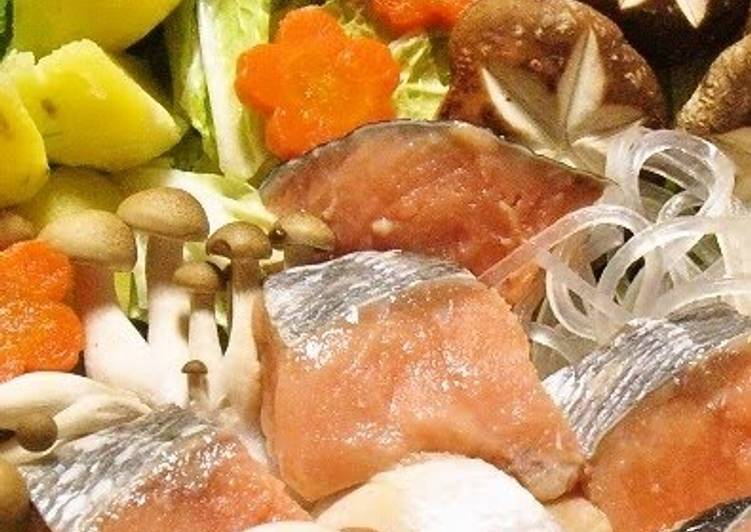Hokkaido Specialty: Salmon & Vegetable Hotpot. Hokkaido Specialty: Salmon & Vegetable Hotpot The miso and the rich butter make this salmon and vegetable hotpot so delicious. The point is to add the combined miso ingredients in two batches. Adding butter makes this hotpot very rich.
 Its geographical location is a blessing bringing with it, cold waters that are an ideal source of fish and even sea vegetation.
The point is to add the combined miso ingredients in two batches.
Adding butter makes this hotpot very rich.
You can cook Hokkaido Specialty: Salmon & Vegetable Hotpot using 13 ingredients and 8 steps. Here is how you cook it.
Its geographical location is a blessing bringing with it, cold waters that are an ideal source of fish and even sea vegetation.
The point is to add the combined miso ingredients in two batches.
Adding butter makes this hotpot very rich.
You can cook Hokkaido Specialty: Salmon & Vegetable Hotpot using 13 ingredients and 8 steps. Here is how you cook it.
Ingredients of Hokkaido Specialty: Salmon & Vegetable Hotpot
- It's 400 grams of Fresh salmon.
- Prepare 1 of Chinese cabbage, potatoes, kudzu noodles, Japanese leek, carrot, shiitake, enoki, shimeji mushrooms, mizuna, etc..
- You need 20 grams of Butter.
- Prepare of Sauce:.
- You need 1200 ml of Kombu based dashi stock.
- Prepare 80 grams of Miso.
- You need 2 tbsp of Mirin.
- Prepare 1 tsp of Sugar.
- Prepare 2 tbsp of Sake.
- Prepare of Ramen to finish.
- Prepare 3 of servings Chinese noodles.
- You need 5 slice of Char siu.
- Prepare 1/4 tsp of Doubanjiang.
If you are using salted salmon, decrease the amount of miso. Hokkaido ramen also differs depending on the area: miso ramen in Sapporo, soy-based in Asahikawa, while in Hakodate ramen with a salt broth is king. Finally, two typical dishes to try: Ishikari-nabe : salmon with vegetables, tofu and konnyaku (konjac, or devil's tongue) simmered in a seaweed broth flavored with miso. Consuming raw or undercooked MEAT, POULTRY, SEAFOODS, SHELLFISH OR EGGS may increase.
Hokkaido Specialty: Salmon & Vegetable Hotpot step by step
- Wash the potatoes and wrap them with plastic wrap while still wet. Microwave for 5 minutes. While hot, use a knife to remove the skins. Boil the carrots..
- Remove the stems from the shiitake mushrooms. To let them easily soak up the flavors of the hot pot, cut a notch on the caps..
- Put the water and the konbu in a hotpot. If possible, leave it for 2 hours. Turn the heat on very low and warm until just before boiling. Let it simmer for about 5 minutes..
- Combine the miso, mirin, sugar, and sake..
- Put the vegetables and salmon into the hotpot. Pour in 2/3 of the combined miso ingredients from Step 4. Add 20 g of butter and heat..
- Once the vegetables have been cooked about 80%, add the remaining 1/3 of the combined miso ingredients from Step 4. Here is when you should add any fillings that cook quickly (such as mizuna, chrysanthemum greens, oysters, etc.).
- After eating the hotpot, add the ramen, char siu, and doubanjang to the pot to make miso ramen!.
- Use the konbu from making the soup stock to make "tsukudani" (preserved food boiled in soy sauce)!. https://cookpad.com/us/recipes/143989-kombu-tsukudani-using-leftover-dashi-kombu.
Hokkaido's cold climate and expansive countryside make it ideal for dairy farming, and Hokkaido is famous for its delicious milk, cream, and butter. This high-quality dairy is the secret to Hokkaido "soft cream", or soft serve ice cream, which tends to have a milkier flavor than other ice creams due to the use of fragrant farm-fresh milk. All you can eat for dine-in, order online for take out. Serving Seafood, Sushi, Chinese & Hibachi. The origin of the dish comes from a town called Ishikari, located western part of Hokkaido.